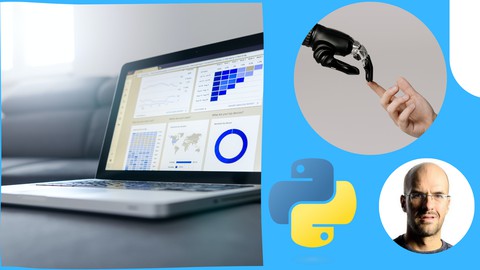
Modern Data Wrangling with AI and Python – Beginner to Pro
Modern Data Wrangling with AI and Python – Beginner to Pro, available at $74.99, has an average rating of 5, with 185 lectures, based on 2 reviews, and has 325 subscribers.
You will learn about Use AI and Python to increase the effectiveness of performing data-related tasks Employ data wrangling to get to the answers, latent in data, quicker and more accurately Reduce the complexity and tedium of maintaining data products, such as adding new rows to a spreadsheet Publish work done on data for other users to consume Move from being frustrated with the limitations of spreadsheets to using Python with confidence Understand the importance and benefits of data wrangling as part of the data lifecycle This course is ideal for individuals who are Data professionals, such as accountants and analysts, who want to learn about data wrangling or Data professionals who want to use AI to increase their productivity level significantly or Anyone curious about AI and how it can be used in the real world, right now It is particularly useful for Data professionals, such as accountants and analysts, who want to learn about data wrangling or Data professionals who want to use AI to increase their productivity level significantly or Anyone curious about AI and how it can be used in the real world, right now.
Enroll now: Modern Data Wrangling with AI and Python – Beginner to Pro
Summary
Title: Modern Data Wrangling with AI and Python – Beginner to Pro
Price: $74.99
Average Rating: 5
Number of Lectures: 185
Number of Published Lectures: 185
Number of Curriculum Items: 185
Number of Published Curriculum Objects: 185
Original Price: $27.99
Quality Status: approved
Status: Live
What You Will Learn
- Use AI and Python to increase the effectiveness of performing data-related tasks
- Employ data wrangling to get to the answers, latent in data, quicker and more accurately
- Reduce the complexity and tedium of maintaining data products, such as adding new rows to a spreadsheet
- Publish work done on data for other users to consume
- Move from being frustrated with the limitations of spreadsheets to using Python with confidence
- Understand the importance and benefits of data wrangling as part of the data lifecycle
Who Should Attend
- Data professionals, such as accountants and analysts, who want to learn about data wrangling
- Data professionals who want to use AI to increase their productivity level significantly
- Anyone curious about AI and how it can be used in the real world, right now
Target Audiences
- Data professionals, such as accountants and analysts, who want to learn about data wrangling
- Data professionals who want to use AI to increase their productivity level significantly
- Anyone curious about AI and how it can be used in the real world, right now
Welcome to “Modern Data Wrangling with AI and Python: From Beginner to Pro.” This comprehensive course is designed to equip participants with the essential skills and knowledge to effectively wrangle and manipulate data using the power of Python and integrate cutting-edge AI techniques.
In today’s data-driven world, the ability to wrangle and process data efficiently is fundamental for successful decision-making, predictive modelling, and gaining valuable insights. This course is structured to take learners on a journey from the basics of data wrangling to advanced AI-powered data manipulation, enabling them to become proficient practitioners in the field.
This course begins by showing you how to install all the modern toolsrequired for data wrangling. Next, we dive right into data exploration. We immediately start coding. After we’ve written our first code, we go over the concepts in a theoretical section.
After data exploration, we cover structured data. After structured data comes unstructured data, including how to work with PDF files in data wrangling. Next, we cover, semi-structured dataand web services, or APIs. In the structuringsection, we try to answer the question – how do I make my data more useful? Next, we look at cleaning upour data. After we’ve cleaned up the data, we learn how to enrich data to make it more valuable. After enrichment comes data validation and we wrap up with publishing.
In total, there are more than 180 videos in this course and you’ll be well-versed in data wrangling once you’ve completed it.
Course Curriculum
Chapter 1: Welcome
Lecture 1: Welcome to the course
Lecture 2: Meet Gerhard
Lecture 3: Is this course for you?
Lecture 4: What will you get out of this course?
Lecture 5: What's in this course?
Chapter 2: Getting Started
Lecture 1: Introduction
Lecture 2: Visual Studio Code – Installing and getting Started
Lecture 3: Adding Extensions to VSC
Lecture 4: GitHub copilot
Lecture 5: Create a Github account
Lecture 6: GitHub Copilot chat
Lecture 7: GitHub Copilot continued
Lecture 8: Testing if Copilot is working
Lecture 9: Github copilot help content
Lecture 10: Anaconda
Lecture 11: Installing Github Desktop
Lecture 12: The GitHub Desktop Interface
Lecture 13: The repository for this course
Lecture 14: GIT (optional)
Lecture 15: Summary
Chapter 3: Data Exploration – What can you tell me about the data?
Lecture 1: Introduction
Lecture 2: A spreadsheet program
Lecture 3: The challenge with spreadsheets
Lecture 4: Follow along with me
Lecture 5: Welcome to Python (and AI)
Lecture 6: Markdown and Code fields in Jupyter
Lecture 7: What is Pandas?
Lecture 8: Read a file in Pandas and display it
Lecture 9: Describe the data
Lecture 10: Do more with Copilot, Jupyter and Python
Lecture 11: Summary
Chapter 4: Enough Python to start your journey
Lecture 1: Introduction
Lecture 2: Libraries
Lecture 3: More Pandas
Lecture 4: Objects
Lecture 5: Getting help from Large Language Models
Lecture 6: Methods
Chapter 5: My journey to data wrangling
Lecture 1: Summary
Lecture 2: My journey
Chapter 6: Structured Data – Tables
Lecture 1: Introduction
Lecture 2: Structured Data
Lecture 3: Structured Data in Python
Lecture 4: CSV files as structured data
Lecture 5: Excel data as structured data
Lecture 6: General methods for structured data – Excel and CSV
Lecture 7: SQL Tables
Lecture 8: SQL data in Python
Lecture 9: Summary
Chapter 7: More on Python – functions, properties and some other goodies
Lecture 1: Introduction
Lecture 2: Functions
Lecture 3: Function signatures
Lecture 4: Function bodies
Lecture 5: Using fucnctions
Lecture 6: A function in action
Lecture 7: Properties
Lecture 8: Properties in code
Lecture 9: For loops
Lecture 10: For loops in code
Lecture 11: Another example of for loops
Lecture 12: Getting help – Docstrings and signatures
Lecture 13: Getting help – online documentation
Lecture 14: Getting help – LLMs
Lecture 15: Getting help – Github copilot
Lecture 16: Summary
Chapter 8: Unstructured Data
Lecture 1: Introduction
Lecture 2: Installing Tabula in condas
Lecture 3: Tables in PDF documents
Lecture 4: Extracting a table from a PDF with Python
Lecture 5: Accessing particular cells in a dataframe
Lecture 6: Rename the columns of a dataframe
Lecture 7: Rename columns 2 and 3 of the dataframe
Lecture 8: Rename the remainder of the columns and concatenate strings
Lecture 9: Delete rows from a dataframe
Lecture 10: Split values in a column
Lecture 11: Drop columns in a dataframe
Lecture 12: PDFs with text
Lecture 13: Extract text from PDFs, using Python
Lecture 14: Summary
Chapter 9: Web services or Application Web Interfaces(APIs)
Lecture 1: Introduction
Lecture 2: Web services or Application Programming Interfaces(APIs)
Lecture 3: The cat facts API
Lecture 4: HTTP response status codes
Lecture 5: JSON payloads
Lecture 6: More on JSON
Lecture 7: Import API call into Postman
Lecture 8: Making an API call in Postman
Lecture 9: Generate code in Postman
Lecture 10: Execute Postman code in a Jupyter Notebook
Lecture 11: Querying JSON objects in Python
Lecture 12: Accessing lists and nested values in JSON
Lecture 13: Converting JSON to Dataframes
Instructors
-
Gerhard van Deventer
Data Professional – Engineer, Architect, Nerd
Rating Distribution
- 1 stars: 0 votes
- 2 stars: 0 votes
- 3 stars: 0 votes
- 4 stars: 0 votes
- 5 stars: 2 votes
Frequently Asked Questions
How long do I have access to the course materials?
You can view and review the lecture materials indefinitely, like an on-demand channel.
Can I take my courses with me wherever I go?
Definitely! If you have an internet connection, courses on Udemy are available on any device at any time. If you don’t have an internet connection, some instructors also let their students download course lectures. That’s up to the instructor though, so make sure you get on their good side!
You may also like
- Top 10 Financial Technology Courses to Learn in December 2024
- Top 10 Agile Methodologies Courses to Learn in December 2024
- Top 10 Project Management Courses to Learn in December 2024
- Top 10 Leadership Skills Courses to Learn in December 2024
- Top 10 Public Speaking Courses to Learn in December 2024
- Top 10 Affiliate Marketing Courses to Learn in December 2024
- Top 10 Email Marketing Courses to Learn in December 2024
- Top 10 Social Media Management Courses to Learn in December 2024
- Top 10 SEO Optimization Courses to Learn in December 2024
- Top 10 Content Creation Courses to Learn in December 2024
- Top 10 Game Development Courses to Learn in December 2024
- Top 10 Software Testing Courses to Learn in December 2024
- Top 10 Big Data Courses to Learn in December 2024
- Top 10 Internet Of Things Courses to Learn in December 2024
- Top 10 Quantum Computing Courses to Learn in December 2024
- Top 10 Cloud Computing Courses to Learn in December 2024
- Top 10 3d Modeling Courses to Learn in December 2024
- Top 10 Mobile App Development Courses to Learn in December 2024
- Top 10 Graphic Design Courses to Learn in December 2024
- Top 10 Videography Courses to Learn in December 2024






















